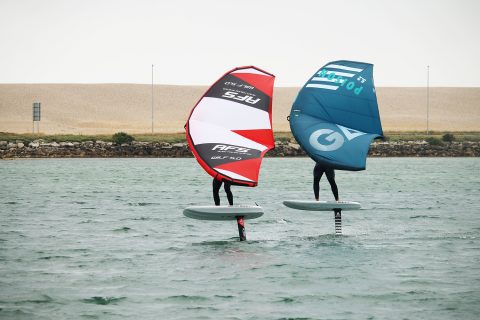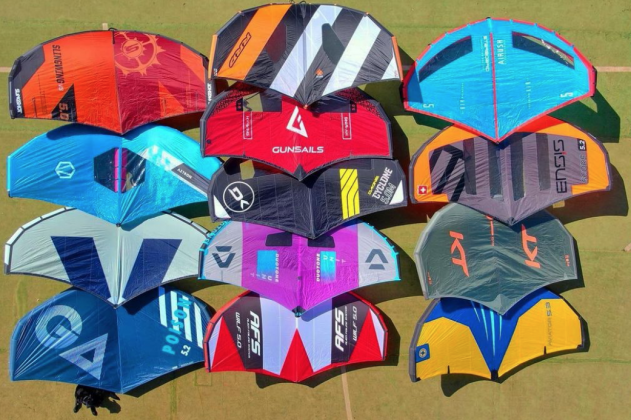5.0 FREERIDE WING TEST 2022
The test team review a selection of the latest 5.0 freeride wings on the market.
TEST EDITOR: TRIS BEST // SECOND TESTERS: MAURIN ROTTENWALTER, SCOTT STALLMAN, JOE NORTH, ROB YORK. // PHOTOS: TRIS BEST //LOCATION: PORTLAND HARBOUR
FINDINGS
The progression and improvement seen in the wing market in just twelve months is staggering. We could go on forever and write chapter and verse about the pros and cons seen in high or low aspect outlines, shallow or deep dihedral profiles, or various other features and techniques employed by brands to distinguish their product. But ultimately, there are three main areas of progression that we’d like to identify: stiffness, weight and handles.
Stiffness
As with inflatable technology in stand-up paddle boards, there’s a race to provide stiffness in the framework of wings … and the strategies employed sound very familiar – higher pressures, larger chambers and new exotic materials … or any combination of the above. Stiffness means stability in structure and in flight, ensuring consistency in the feedback the wing provides. In general wings are becoming more stable, with their power centred and less turbulence through their wingtips, which in turn means their wind ranges are extending. The key action for you to fulfil is to put the desired pressure into the wing before every session … and in some cases even more than the recommended pressure stated on the wing!
Weight
Unlike iSUPs, the weight of a wing is of paramount importance. The saving of a few grams can make all the difference, especially in the lightest airs, when it can mean the difference between the wing flying freely or you feeling as if you’re holding it up. New shaping techniques and concepts have also come into play, allowing wings to lift and fly more easily. New materials are also entering the market, professing to be lighter than ever without any detraction in durability. Time will tell.
Handles
The biggest change we’ve seen, however, is in handle technology. There’s a steady migration towards rigid handles and the advantages are tangible for most, spelling more immediate response and control over the wing. They’re a sort of halfway house between a full-length boom and flexible material handles, and it’ll be interesting to see whether they become the standard in future years. And finally, as an indicator of where we’re going, more than half these wings have harness line fixings on their booms, as riders wing for longer, covering greater distances in wider wind ranges.

SUMMARY
Starting with the low aspect wings and the rebranded Air V2 from FreeWing (Starboard and Airush’s fledgling winging-brand), is one of the older designs here, providing the leverage and flex to pump and make the most of its compact shape. The KT is a big wing in the hands and has a unique and useful handle setup, whilst the arrowhead shaped Hy-Wing from Gunsails has a more conventional and much improved handle configuration compared to its predecessor. The all-new Nova from North also adopts a low aspect outline, a more centred power delivery and some extra-long rigid handles, which were certainly popular amongst the team. At the other end of the spectrum, the high aspect wings in the group included the AFS Wilf, which is quite a bit smaller in chord length to others, yet generates an impressive amount of power, just pump it up beyond the recommended 6 PSI. The new Vayu Aura is a crisp, manoeuvre-oriented wing with switchable handles, albeit the hard handles were unanimously favoured. Finally, the new Cabrinha Mantis V2 is a direct feeling powerhouse. All the other wings are medium aspect, and we start with the Ensis Score – an unchanged wing for this season from a brand that largely set the standard for wings in direct feel and response, thanks to its tight elongated handles. There’s the V2 Wing from Aztron, with its much-improved performance and weight, whilst retaining a very competitive price tag. There are the statesman brands in the winging world – Duotone with the Unit and Naish with the Wing-Surfer Mk4. Both using their experience and expertise to further their product – the Unit with class leading handles and the Naish with its stunning wind range. RRD have really developed their Wind Wing for Y27, with a sharper and more dynamic nature, whilst the Poison from GA takes top spot for being the most lightweight, with the performance benefits tangible on the water. The Slingshot SlingWing V3 boasts the stiffest frame in the group with the stability to match. The Aviator from Unifiber is the first of no doubt many iterations to come from the brand, with a good performance range, though its immediacy is let down by its handle structure. Last but by no means least is the Dakine Cyclone – a new entry into the winging world yet with transferred heritage, it has a much-liked handle structure and should be pumped to a higher PSI than that recommended to make the most of its potential.
THE LINEUP

